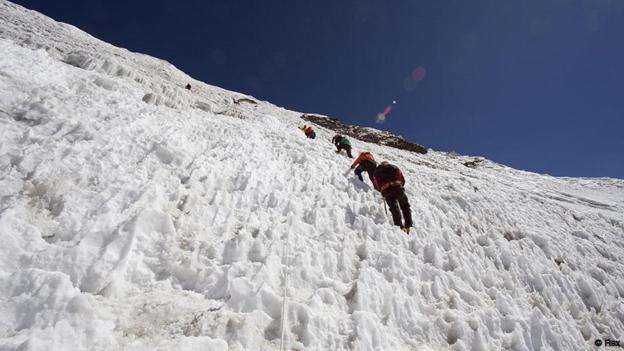Climbing Mount Everest is one of the greatest challenges known to man. It’s certainly among the most perilous. At least six climbers have been killed in the past three days on the world’s tallest mountain.
Death on Everest comes in many forms: from violence, to silence, avalanches, to heart stopping cold.
Last Thursday, a 25-year-old Nepalese guide fell to his death.
Since Friday, a Dutch climber, an Australian woman, and an Indian man, are suspected to have succumbed to altitude sickness: death by drowning, on a mountain 29,000 feet above sea level.
Altitude sickness can be mild or extremely serious, said Jim Davidson, who knows Everest’s dangers well. He was there last year when an earthquake and avalanche killed 19 people.
“When it gets really bad it can get water pooling in your lungs, water pooling in your brain and it can be fatal in just a day or so when it strikes at a very serious level,” he said.
Davidson says things have improved over the years.
“But we will never get the risk down to zero because it’s a dangerous game and a lot of things can go wrong in high altitude,” he said.
At sea level, oxygen makes up about 21 percent of air. At higher altitude, it’s 21 percent as well, but in the thin air there are fewer oxygen molecules per breath. At 18,000 feet, one breath of air has half the amount of oxygen as at sea level.
Two expert Americans, Adrian Ballinger and Cory Richards, expected to summit Monday, are using live Snapchats to show the world the extremes climbers endure.
Since Tenzing Norgay and Edmund Hillary first conquered Everest in 1953, 4,000 climbers managed to do the same. But over 260 have died trying to reach the heavens.
On Monday, the bodies of two more Indian climbers were found.
Avalanches have taken an especially terrible toll on climbers, killing 35 in just the past two years. Since 1900, at least one person has died on Everest every year.
Wikipedia extract
Mount Everest attracts many climbers, some of them highly experienced mountaineers. There are two main climbing routes, one approaching the summit from the southeast in Nepal (known as the standard route) and the other from the north in Tibet. While not posing substantial technical climbing challenges on the standard route, Everest presents dangers such as altitude sickness, weather, wind as well as significant objective hazards from avalanches and the Khumbu Icefall. As of 2016, there are well over 200 corpses still on the mountain, with some of them even serving as landmarks.
CBS News with Wikipedia extract














